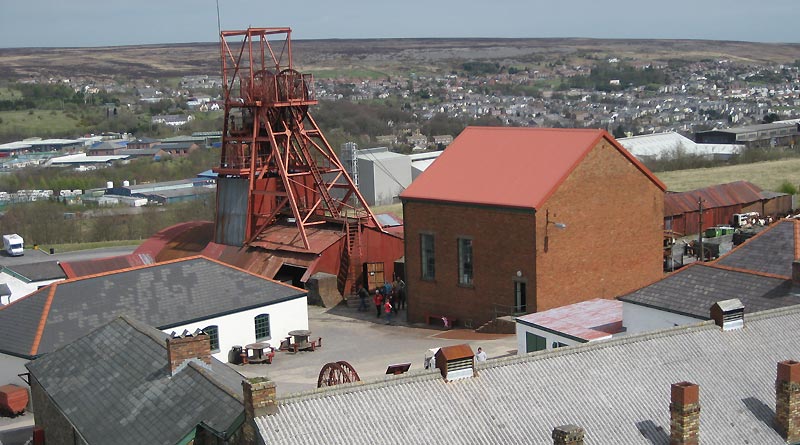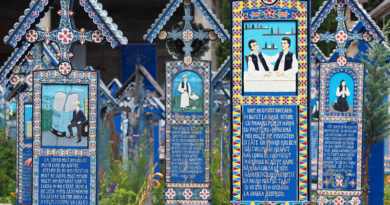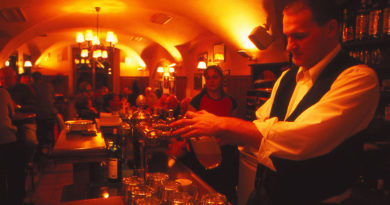No ordinary hole
It isn’t often that a hole in the ground is voted the best museum in Britain. Nor are there many holes on the United Nations’ World Heritage list – but this is no ordinary hole in the ground.
Dug in 1880 and shut down 100 years later, Big Pit was one of hundreds of coal mines that riddled the South Wales landscape.
Mining was especially important in the Valleys, a string of gritty, working class towns that sprang up north of Cardiff in the clefts radiating from Southern Britain’s highest mountains.
The Welsh aren’t exaggerating when they say they made the Industrial Revolution happen – at their peak the Valleys produced a third of the world’s coal, employed a quarter of a million miners, and boasted the world’s biggest iron works.
But that all came to a bitter end in the 1980s when Prime Minister Margaret Thatcher crushed the unions after the year-long miners’ strike, and coal mining in South Wales was all but shut down. The Valleys lost two-thirds of their population with just a handful of mines – including Big Pit, now the World Heritage-listed National Mining Museum – preserved as reminders of a lost way of life.
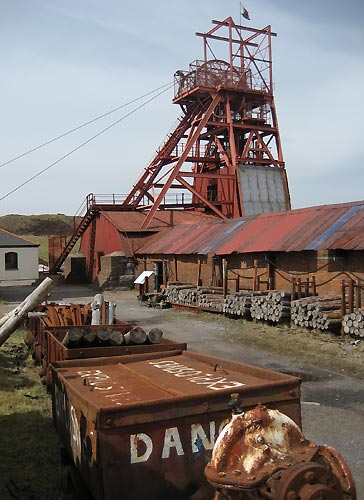
Big Pit’s status as one of Wales’ seven national museums means entry is free. That and its accolades – it was voted best museum in Britain in 2005 – also means it gets a lot of visitors, so you have to wait for a spot on an underground tour, the museum’s highlight.
My group was led by the Hobbit-like Glyn, who punctuated every sentence with an “all right, yeah?” and was barely over five foot tall. I soon learned this was a useful attribute underground.
We were issued with helmets, lamps, heavy battery packs and “self-rescuer” masks to filter out toxic gases, and handed over our watches, cameras and phones – anything battery-powered could spark an explosion, Glyn explained.
We then squeezed into a cage lift and plunged 100m to the bottom of the pit as Glyn told us how, at its peak in the 1920s, 1300 people worked in the mine in grim and often dangerous conditions.
Until the 1840s women and children were paid a few pence a week to push wagons laden with coal through the tunnels; horses, too, were worked ruthlessly, replaced by trains only in the 1970s. The horses were brought to the surface for two weeks a year, but still got a better deal than the miners – horses only had to haul wagons for eight hours at a time and were fed every four.
As we shuffled through steadily smaller tunnels, I saw Glyn wasn’t joking when he said the ideal miner was five foot two inches tall and six foot wide.
“Look out for your heads, all right, yeah?” he instructed as I, right on cue, whacked my helmet on an iron strut. He showed us a coal face where miners hacked at the seam in a space little more than a metre high; then, next to a torrent of rust-coloured water, he made us switch off our lamps to appreciate how dank, damp, dark and claustrophobic it would have been in the pit – even if wasn’t a patch on the filth and noise and danger of a working mine.
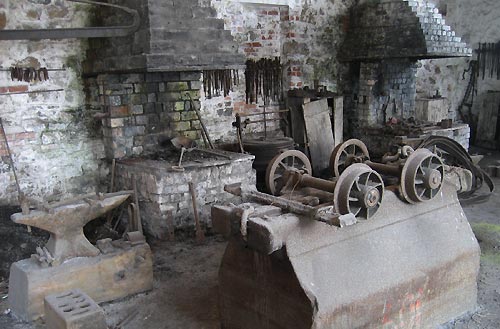
Glyn also told us about the epic miners’ dispute of 1984-85, when he and thousands of other Welshmen spent a year on strike, living on nothing but donations of baked beans and corned beef.
“I’ll never eat corned beef again,” he said with a grimace.
In the end 29 mines were shut down and 20,000 miners lost their jobs. One mine was bought out by the workers and run as a cooperative, only closing down earlier this year when it finally became uneconomic.
The rest of the museum fills in the gaps of a vanished way of life. Recordings recreate the din and camaraderie of the railway yard, workshops and locker rooms; you’d swear a bunch of miners had just finished their shift and were scrubbing down in the showers, singing Tom Jones numbers and clearing coal dust from their noses.
Other displays tell the story of the equally harsh lives of the miners’ wives, many of whom died in childbirth in cramped and squalid cottages; or the tragedy at Aberfan in 1966, when a collapsing slag heap buried a school and killed 144 people, mainly children.
To cap off a day of exploring Blaenafon’s industrial heritage – which as well as Big Pit includes the ruins of the 18th century’s biggest iron works, miners’ chapels modelled on engine houses, and tightly packed rows of miners’ cottages – I took a bus south to Newport, a post-industrial city just east of Cardiff.
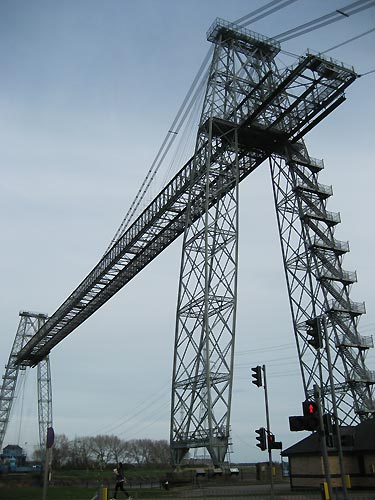
With its dusty building sites and soulless concrete buildings strung along the muddy River Usk, there can’t be many less attractive cities in Britain – but it is a fascinating snapshot of 21st century Britain.
Unlike the towns further west there’s barely a sign of the Welsh language; in fact, on the main drag there’s not much sign of English. Instead Bollywood video shops rub shoulders with Polish grocery stores, and young men in hoodies swill cheap lager while women wrapped in saris scurry past.
But Newport has one redeeming feature – its extraordinary Transporter Bridge. Built, like the Eiffel Tower, by a Frenchman just over 100 years ago, the bridge used cutting-edge engineering to solve a vexing problem.
Then, as now, most people in Newport lived on the west bank of the Usk, but the giant, labour-hungry steelworks was on the east bank. A bridge would have been impossibly high, or would have blocked shipping and killed the city’s busy port. A tunnel would have been impossibly expensive and ferries were hampered by the river’s strong currents and freakish tides – the 14m difference between high and low tides is one of the biggest in the world.
Then the borough engineer heard about a “transbordeur” bridge in France, in effect an aerial ferry suspended from rails high above the river. Newport’s Transporter Bridge, one of a dozen or so in the world, was built between 1902 and 1906 for the then vast sum of £98,000.
The track spans 200m and is supported on four steel pylons, each 80m high. A gondola whisked passengers and up to six carriages or cars at a time from bank to bank, originally for a fare of half a penny.
It operated until 1985 when an engineering survey found it was unsafe. The bridge reopened with great fanfare in 1995 after millions of pounds were spent restoring it; alas, it cost a fortune to run and closed again in 2007. It now operates only a few weekends a year.
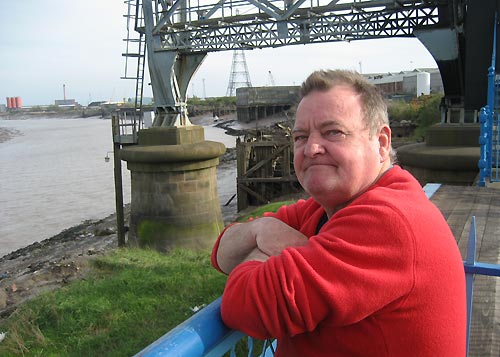
Ray Morgan, possibly the world’s biggest transporter bridge fan, must have spotted my dejection as I discovered I’d walked across Newport to look at a closed bridge. He came darting out of his terrace house overlooking the Usk, armed with a stack of pamphlets and stories about his neighbourhood technological wonder.
He even invited me back to his home for a cuppa and a glimpse of his collection of photos, news clippings and other bridge paraphernalia.
Ray explained that his wife had passed away five years ago; I suspected the bridge and its visitors kept him company instead. He was certainly the best ambassador a bridge could have.
With their slag heaps, disused mines and gritty industrial towns, the Valleys hardly seem an ideal tourist attraction. But if you’re overdosing on thatched cottages and cutesy tea shops, the industrial heritage of South Wales makes a good antidote – and a fascinating insight into a lost way of life in the world’s first industrialised nation.
· · · · ·
This piece was written in 2008 when I was lucky enough to win a month-long journalism fellowship at Cardiff University in Wales.
The prize, sponsored by the British High Commission and Air New Zealand, included a month-long stay in the Welsh capital, where I sat in on classes of the international diploma in journalism, visited newsrooms, went hiking in Snowdonia, poked around a few of the hundreds of castles that dot the Welsh landscape, and checked out Wales’ industrial heritage.

